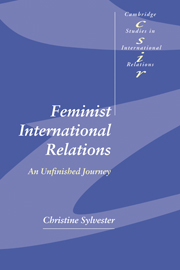Book contents
- Frontmatter
- Contents
- Acknowledgments
- Part I Introduction
- Part II Sightings
- Part III Sitings
- 8 The emperors' theories and transformations: looking at the field through feminist lenses
- 9 Feminists and realists view autonomy and obligation in international relations
- 10 Some dangers in merging feminist and peace projects
- 11 Gendered development imaginaries: shall we dance, Pygmalion?
- 12 Empathetic cooperation: a feminist method for IR
- Part IV Citings
- References
- Index
- CAMBRIDGE STUDIES IN INTERNATIONAL RELATIONS
10 - Some dangers in merging feminist and peace projects
Published online by Cambridge University Press: 22 September 2009
- Frontmatter
- Contents
- Acknowledgments
- Part I Introduction
- Part II Sightings
- Part III Sitings
- 8 The emperors' theories and transformations: looking at the field through feminist lenses
- 9 Feminists and realists view autonomy and obligation in international relations
- 10 Some dangers in merging feminist and peace projects
- 11 Gendered development imaginaries: shall we dance, Pygmalion?
- 12 Empathetic cooperation: a feminist method for IR
- Part IV Citings
- References
- Index
- CAMBRIDGE STUDIES IN INTERNATIONAL RELATIONS
Summary
Here is a plunge into and around war via siting issues of feminism, women's identities, and peace. I ask: are women peace-loving? Can we build peace projects on the backs of women more so than men? Feminists have taken sides on this issue for at least sixteen years. Standpoint feminism, which anchors social theory to women's gendering experiences and daily activities, often suggests that aspects of women's lives render them less aggressive than men and less likely to support wars. Feminist postmodernism, chary of sharp characterizations of “women,” insists that gender traits are not authentic so much as discursively repetitive about which bodies belong where doing what. “Some Dangers” compares the two feminist ways of considering the women question around feminist peace concerns, and comes away appreciative of postmodern skepticisms vis-à-vis maternal standpoint thinking.
Nancy Hirschmann's (1992) psychoanalytic version of standpoint thinking, in which adult gender inclinations tend to reflect preconscious attachments and differentiations of body identity reinforced by social instruction, still stands as one of the best. There is danger, however, in predicting adult behavior from pre-adult influences or in suggesting that men and women everywhere have imbibed the same early gendering lessons. It is thus unwise for feminists to assign peace to women on the basis of gender-reinforcing links to a similar-sex mother (to say nothing of instances in which mother is a man). Jean Elshtain, herself a maternal feminist (among other things), shows us war and peace sewn together around war and its narrative assignments.
- Type
- Chapter
- Information
- Feminist International RelationsAn Unfinished Journey, pp. 207 - 223Publisher: Cambridge University PressPrint publication year: 2001



